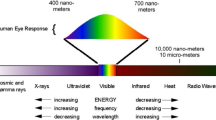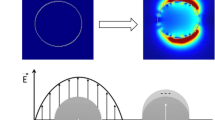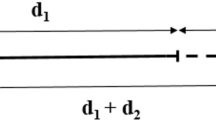Abstract
The nanoparticle-on-mirror system as a surface-enhanced Raman scattering substrate is sufficient for single molecule detection and possesses advantages of high reproducibility and ease of assembly. In this paper, one single spherical gold nanoparticle (NP) placed on a flat gold substrate with a gap size of 10 nm is firstly studied. Then, two NPs with separations in order of wavelengths is investigated. The enhanced field of the localized gap surface plasmon (LGSP) in the NP-substrate nanogap is analyzed quantitatively with the finite element method, and a simplified model is proposed to describe the impact of the propagative surface plasmon polariton (SPP) on the LGSP. A 34% improvement of the enhancement factor of the Raman signal is achieved compared to a single NP. The field distribution of SPPs is found to play an important role in determining the optimal positions of NPs to generate the strongest hot spots. Then, the case of a single NP or a NP doublet in a gold groove is considered, and an 8.22-fold increase of the enhancement factor of the Raman signal is obtained compared to the case without the groove. The interference among the groove-excited SPPs, the NP-excited SPPs, and the LGSP determines the optimal positions of the NPs in the groove to generate the strongest hot spots. The present work reveals the great impact of the propagative SPPs on the field enhancement of the LGSP in the NP-substrate gap, and provides a theoretical basis for generating multiple strong hot spots by arranging NPs’ positions according to the field distribution of the propagative SPPs.









Similar content being viewed by others
References
Nie S, Emory SR (1997) Probing single molecules and single nanoparticles by surface-enhanced Raman scattering. Science 275:1102–1106
Xu H, Bjerneld EJ, Käll M, Börjesson L (1999) Spectroscopy of single hemoglobin molecules by surface enhanced Raman scattering. Phys Rev Lett 83:4357–4360
Ding S, You E, Tian Z, Moskovits M (2017) Electromagnetic theories of surface-enhanced Raman spectroscopy. Chem Soc Rev 46:4042–4076
Sonntag MD, Klingsporn JM, Zrimsek AB, Sharma B, Ruvuna LK, Van Duyne RP (2014) Molecular plasmonics for nanoscale spectroscopy. Chem Soc Rev 43:1230–1247
Talley CE, Jackson JB, Oubre C, Grady NK, Hollars CW, Lane SM, Huser TR, Nordlander P, Halas NJ (2005) Surface-enhanced Raman scattering from individual Au nanoparticles and nanoparticle dimer substrates. Nano Lett 5:1569–1574
McLellan JM, Siekkinen A, Chen J, Xia Y (2006) Comparison of the surface-enhanced Raman scattering on sharp and truncated silver nanocubes. Chem Phys Lett 427:122–126
Wiley BJ, Chen Y, McLellan JM, Xiong Y, Li Z, Ginger D, Xia Y (2007) Synthesis and optical properties of silver nanobars and nanorice. Nano Lett 7:1032–1036
Fang J, Liu S, Li Z (2011) Polyhedral silver mesocages for single particle surface-enhanced Raman scattering-based biosensor. Biomaterials 32:4877–4884
Lim DK, Jeon KS, Kim HM, Nam JM, Suh YD (2010) Nanogap-engineerable Raman-active nanodumbbells for single-molecule detection. Nat Mater 9:60–67
Kleinman SL, Ringe E, Valley N, Wustholz KL, Phillips E, Scheidt KA, Schatz GC, Van Duyne RP (2011) Single-molecule surface-enhanced Raman spectroscopy of crystal violet isotopologues: theory and experiment. J Am Chem Soc 133:4115–4122
Das G, Mecarini F, Gentile F, De Angelis F, Mohan Kumar HG, Candeloro P, Liberale C, Cuda G, Di Fabrizio E (2009) Nano-patterned SERS substrate: application for protein analysis vs. temperature. Biosens. Bioelectron 24:1693–1699
Park W, Ahn S, Kim Z (2008) Surface-enhanced Raman scattering from a single nanoparticle–plane junction. Chem Phys Chem 9:2491–2494
Hill RT, Mock JJ, Urzhumov Y, Sebba DS, Oldenburg SJ, Chen S, Lazarides AA, Chilkoti A, Smith DR (2010) Leveraging nanoscale plasmonic modes to achieve reproducible enhancement of light. Nano Lett 10:4150–4154
Li L, Hutter T, Steiner U, Mahajan S (2013) Single molecule SERS and detection of biomolecules with a single gold nanoparticle on a mirror junction. Analyst 138:4574–4578
Mubeen S, Zhang S, Kim N, Lee S, Kramer S, Xu H, Moskovits M (2012) Plasmonic properties of gold nanoparticles separated from a gold mirror by an ultrathin oxide. Nano Lett 12:2088–2094
Benz F, Tserkezis C, Herrmann LO, De Nijs B, Sanders A, Sigle DO, Pukenas L, Evans SD, Aizpurua J, Baumberg JJ (2015) Nanooptics of molecular-shunted plasmonic nanojunctions. Nano Lett 15:669–674
Mock JJ, Hill RT, Degiron A, Zauscher S, Chilkoti A, Smith DR (2008) Distance-dependent plasmon resonant coupling between a gold nanoparticle and gold film. Nano Lett 8:2245–2252
Huang Y, Ma L, Li J, Zhang Z (2017) Nanoparticle-on-mirror cavity modes for huge and/or tunable plasmonic field enhancement. Nanotechnology 28:105203
Lévêque G, Martin OJF (2006) Tunable composite nanoparticle for plasmonics. Opt Lett 31:2750–2752
Lévêque G, Martin OJF (2006) Optical interactions in a plasmonic particle coupled to a metallic film. Opt Express 14:9971–9981
Lombardi A, Demetriadou A, Weller L, Andrae P, Benz F, Chikkaraddy R, Aizpurua J, Baumberg JJ (2016) Anomalous spectral shift of near-and far-field plasmonic resonances in nanogaps. ACS Photonics 3:471–477
Huang S, Ming T, Lin Y, Ling X, Ruan Q, Palacios T, Wang J, Dresselhaus M, Kong J (2016) Ultrasmall mode volumes in plasmonic cavities of nanoparticle-on-mirror structures. Small 12:5190–5199
Huang Y, Ma L, Hou M, Li J, Xie Z, Zhang Z (2016) Hybridized plasmon modes and near-field enhancement of metallic nanoparticle-dimer on a mirror. Sci Rep 6:30011
Chen S, Meng L, Shan H, Li J, Qian L, Williams CT, Yang Z, Tian Z (2016) How to light special hot spots in multiparticle-film configurations. ACS Nano 10:581–587
Li X, Choy WCH, Ren X, Zhang D, Lu H (2014) Highly intensified surface enhanced Raman scattering by using monolayer graphene as the nanospacer of metal film–metal nanoparticle coupling system. Adv Funct Mater 24:3114–3122
Wang X, Li M, Meng L, Lin K, Feng J, Huang T, Yang Z, Ren B (2014) Probing the location of hot spots by surface-enhanced Raman spectroscopy: toward uniform substrates. ACS Nano 8:528–536
Chen F, Huang Y, Wei H, Wang S, Zeng X, Cao W, Wen W (2018) Material influence on hot spot distribution in the nanoparticle heterodimer on film. Phys E 98:1–5
Palik E D (1991) Handbook of optical constants of solids II, Boston
García-Vidal FJ, Pendry JB (1996) Collective theory for surface enhanced raman scattering. Phys Rev Lett 77:1163–1166
Bai Q, Perrin M, Sauvan C, Hugonin JP, Lalanne P (2013) Efficient and intuitive method for the analysis of light scattering by a resonant nanostructure. Opt Express 21:27371–27382
Nikitin AY, García-Vidal FJ, Martín-Moreno L (2010) Surface electromagnetic field radiated by a subwavelength hole in a metal film. Phys Rev Lett 105:073902
Bigourdan F, Hugonin JP, Marquier F, Sauvan C, Greffet JJ (2016) Nanoantenna for electrical generation of surface plasmon polaritons. Phys Rev Lett 116:106803
Jia H, Lalanne P, Liu H (2016) Comprehensive surface-wave description for the nano-scale energy concentration with resonant dipole antennas. Plasmonics 11:1025–1033
Kim S, Shafiei F, Ratchford D, Li X (2011) Controlled AFM manipulation of small nanoparticles and assembly of hybrid nanostructures. Nanotechnology 22:115301
Shafiei F, Monticone F, Le KQ, Liu X, Hartsfield T, Alu A, Li X (2013) A subwavelength plasmonic metamolecule exhibiting magnetic-based optical Fano resonance. Nat Nanotechnol 8:95–100
Sun L, Ma T, Yang S, Kim D, Lee G, Shi J, Martinez I, Yi G, Shvets G, Li X (2016) The interplay between optical bianisotropy and magnetism in plasmonic metamolecules. Nano Lett 16:4322–4328
Min C, Shen Z, Shen J, Zhang Y, Fang H, Yuan G, Du L, Zhu S, Lei T, Yuan X (2013) Focused plasmonic trapping of metallic particles. Nat Commun 4:2891
Zeng Z, Liu H (2012) Electromagnetic enhancement by a T-shaped metallic nanogroove: impact of surface plasmon polaritons and other surface waves. IEEE J Sel Top Quant 18:1669–1675
Funding
This study is financially supported by the National Natural Science Foundation of China (NSFC) (61775105, 11504270), 111 Project (B16027), Engineering Research Center of Thin Film Photo-electronics Technology of Ministry of Education, and International Cooperation Base for New PV Technology.
Author information
Authors and Affiliations
Corresponding author
Additional information
Publisher’s Note
Springer Nature remains neutral with regard to jurisdictional claims in published maps and institutional affiliations.
Rights and permissions
About this article
Cite this article
Zhong, Y., Sun, F. & Liu, H. Impact of Propagative Surface Plasmon Polaritons on the Electromagnetic Enhancement by Localized Gap Surface Plasmons Between Metallic Nanoparticles and Substrate. Plasmonics 14, 1393–1403 (2019). https://doi.org/10.1007/s11468-019-00929-6
Received:
Accepted:
Published:
Issue Date:
DOI: https://doi.org/10.1007/s11468-019-00929-6




